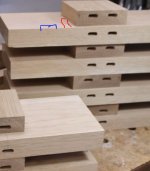ChuckS said:
DF700 users can buy third-party cutters and use the 700 like a DF500. Is there anyone out there
producing and selling longer cutters that we can use a DF500 with longer Dominoes like the 8mm x 22mm x 80mm, or even the 100mm?
Please share the source if anyone knows about such cutters for DF500. Thanks.
Chuck
Hi chuck hey next reader
Intention to inform.
The bit would look outside the mouth we know that for sure.
What we dont know is how much breaking power is applied to the tenon what wood is used and what glue.
To resolve your first question properly...
We drill in the done holes from the df500 with a drill the holes deeper and then take a chisel and cut the "V" that stays between the holes.
That works good for us.
Now how to calculate the maxload for a tenon there are several methodes to an end.
Search for the wood and search for the max loads it can handle. Then caluclate from there the dimension needed.
What gives strong tenons is how wide the domino is , how thick the walls are that hold and then the deepth.
No selfmade domino will carry much load especially when he is slim and long.
He must be thick and long burried into a thick corpus of wood.
The next question would be are the forces in a sher motion or is a leveraction applied to the tenon.
But here you have to calculate what happens.
A good basis is 1:1:0.5
20mm wide x 25mm long x 10mm thick.
Before you try deeper holes widen the cut and add wider dominos that will produce a supirior tenon then one with a deeper hole.
Remember wide/brother dominos carry more than longer. Why because of leverforce applied to a 20mm stick isnt doing anything but leaveraction applied onto a 200mm plank delivers (yes until both break but a plank is 10 times wider so it must deliver at least 10times more!)
To give more strenght to a join we widen the domino holes and applied glue that gives us the best results.
Have fun doing it

